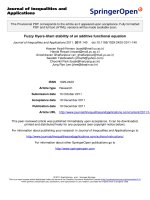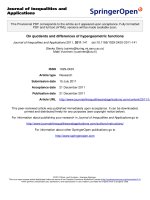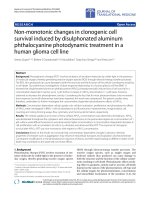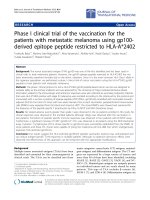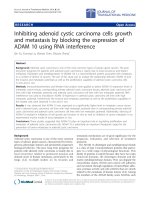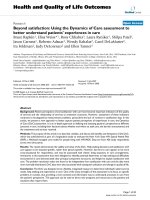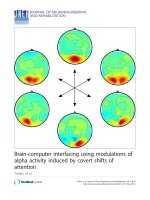Báo cáo hóa học: " Brain-computer interfacing using modulations of alpha activity induced by covert shifts of attention" pdf
Bạn đang xem bản rút gọn của tài liệu. Xem và tải ngay bản đầy đủ của tài liệu tại đây (562.68 KB, 10 trang )
JNER
JOURNAL OF NEUROENGINEERING
AND REHABILITATION
Brain-computer interfacing using modulations of
alpha activity induced by covert shifts of
attention
Treder et al.
Treder et al. Journal of NeuroEngineering and Rehabilitation 2011, 8:24
(5 May 2011)
RESEARC H Open Access
Brain-computer interfacing using modulations of
alpha activity induced by covert shifts of
attention
Matthias S Treder
1*
, Ali Bahramisharif
2,3
, Nico M Schmidt
1
, Marcel AJ van Gerven
2,3
and Benjamin Blankertz
1
Abstract
Background: Visual brain-computer interfaces (BCIs) often yield high performance only when targets are fixated
with the eyes. Furthermore, many paradigms use intense visual stimulation, which can be irritating especially in
long BCI sessions. However, BCIs can more directly directly tap the neural processes underlying visual attention.
Covert shifts of visual attention induce changes in oscillatory alpha activity in posterior cortex, even in the absence
of visual stimulation. The aim was to investigate whether different pairs of directions of attention shifts can be
reliably differentiated based on the electroencephalogram. To this end, healt hy participants (N = 8) had to strictly
fixate a central dot and covertly shift visual attention to one out of six cued directions.
Results: Covert attention shifts induced a prolonged alpha synchronization over posterior electrode sites (PO and
O electrodes). Spectral changes had specific topographies so that different pairs of directions could be
differentiated. There was substantial variation across participants with respect to the direction pairs that could be
reliably classified. Mean accuracy for the best-classifiable pair amounted to 74.6%. Furthermore, an alpha power
index obtained during a relaxation measurement showed to be predictive of peak BCI performance (r = .66).
Conclusions: Results confirm posterior alpha power modulations as a viable input modality for gaze-independent
EEG-based BCIs. The pair of directions yielding optimal performance varies across participants. Consequently,
participants with low control for standard directions such as left-right might resort to other pairs of directions
including top and bottom. Additionally, a simple alpha index was shown to predict prospective BCI performance.
Background
A brain-computer interface (BCI) serves to decode user
intention from brain signals, enabling a direct communi-
cation between brain and computer. Since the main tar-
get group of BCIs is patients with motor impairments, it
is vital that the control of a BCI does not i nvolve motor
activity. However, this is not always the case. For
instance, for the widely used Matrix speller (a.k.a. P300-
speller), evidence accumula tes that BCI control is effi-
cient only when the target symbol is fixated with the
eyes [1-3]. Different routes have been taken to circum-
vent the problem of gaze dependence. For instance, one
may fall back on other sensory modalities such as spatial
auditory [4,5] and tactile feedback [6]. Alternatively, one
may rely on other paradigms such as motor imagery
[7,8]. However, motor imagery paradigms face the pro-
blem that a subset of participants does not obtain signif-
icant BCI control, a problem that is only partially solved
[9-11]. A lso in the visual domain, there have been pro-
mising approaches to gaze-independent BCIs. For
instance, recently, three visual gaze-independent sp ellers
have been introduced [12]. In contrast to the Matrix
spel ler, the selection process was broken down into two
successive steps, and for the best speller, mean symbol
selection accuracy amounted to about 97%. Liu et al.
[13] combined a similar visual design with a visual
search task and reported a peak performance o f 96.3%.
In another study, rapid serial visual presentation of sym-
bols was used, with a mean symbol selection accuracy of
up to 90% for selecting one symbol out of thirty [14].
Note, however, that these paradigms rely on visual sti-
mulation. In particular, they exploit the fact that the
event-related potential (ERP) associated with a visual
* Correspondence:
1
Machine Learning Laboratory, Berlin Institute of Technology, Berlin Germany
Full list of author information is available at the end of the article
Treder et al. Journal of NeuroEngineering and Rehabilitation 2011, 8:24
/>JNER
JOURNAL OF NEUROENGINEERING
AND REHABILITATION
© 2011 Treder et al; licensee BioMed Central Ltd. This is an Open Access article distributed under the terms of the Creative Commons
Attribution License ( which permits unrestricted use, distribution, and reproduction in
any medium, provided the original work is properly cited.
stimulus can b e modulated by attention. In the p resent
study, we take a more fundamental approach. It has
been shown that covert spatial attention shifts are
accompanied by power changes in the alpha band (8-12
Hz)oftheelectroencephalogram(EEG)atposterior
electrode sites [15]. Therefore, rather than measuring
the effects of attention on the neural response to visual
stimulation, we directly tap the neural process underly-
ing covert attention shifts. This approach has several
advan tages over conventional paradigms based on ERPs.
First, continuous visual stimulation, which can be
tedious and irritating especially in long BCI sessions, is
super fluous. Second, for some application domains such
as spatial navigation, it seems more intuitive to shift
attention to the desired location rather than to p erform
a task such as counting the occurrences of a flashing
target. Third, a BCI based on changes in oscillatory
alpha activity potentially allows for asynchronous con-
trol. That is, the user initiates a cov ert attention shift
whenever he or she wants to issue a command, whereas
in an ERP paradigm, the user has to adhere to the pace
and timing of the visual stimulation sequence.
Kelly et al. suggested that the alpha paradigm may
indeed be a feasible input modality for EEG-based BCIs
[16]. Participants were instructed to deploy covert spa-
tial attention to a target that was located either left or
right of the fixation point. Offline classification showed
that it is possible to discern attention shifts to either
direction based on modulations of the posterior alpha
rhythm. However, one of the cave ats of this study was
that the authors used targets flickering in different fre-
quencies. Since the flickering might interact with the
deployment of attention, it is unclear how these results
trans fer to a paradigm without continuous visual stimu-
lation. Recent studies using magnetoencephalography
(MEG) mapped out multiple directions of attention
shifts. It was shown that shifts to multiple spatial direc-
tions, including top and bottom, yield distinctive pat-
terns of alpha modulation [17] that can be reliably
classified [ 18,19]. Follow-up studies investigated the role
of stimulus eccentricity [20] and showed that arbitrary
directions can be decoded [21]. However, it remained
unclear whether the results from MEG transfer to EEG.
After all, the former has a substantially higher spatial
resolution which allows for a more accurate estimate of
the topographical distribution of alpha power. Regarding
practical application, however, an EEG-based solution is
desirable due to its lower cost, portability, and the possi-
bility to use it in a home environment. The aim of the
present study was to bring together these strands of
research on visual alpha based BCIs. Expanding on the
work by Kelly et al. [16], we investigated whethe r atten-
tion shifts to directions other than left-right would also
induce distinctive patterns of alpha modulation. To this
end, we conducted an offline experiment wherein eight
healthy participants had to shift covert spatial attention
to one out of six possible targe t directions while strictly
fixating the center of the display (see Figure 1). After a
variable amount of time (500-2000 ms), a symbol (either
‘+’ or ‘×’) appeared on one of the six targets and partici-
pants had to indicate which one it was by pressing one
of two buttons. Participants were instructed to respond
as fast as possible. In 80% of the trials, the symbol
appeared on the attended disc (valid condition), whereas
in 20% of the trials, the symbol appeared on one of the
other five discs (invalid co ndition). This was intended to
control whether participants shifted a ttention to the
cued location, since the reaction times should be shorter
when the target appears at an attended location than
when it appears at an unattended location. Refer to the
methods section for more details. We will first report
the behavioral results. Subsequently, we address neuro-
physiology and classification data. We then expand on
the classification data by investigatin g contributions of
left hemisp here versus right hemisphere electrode sites.
Finally, we introduce a predictor of BCI performance
based o n the alpha rhythm during relaxation. Prelimin-
ary results of this study have been presented at a confer-
ence [22].
Results and discussion
Behavioral results
Overall response accuracy was 86.62% ± 8.46% SEM.
The accuracies in the valid and invalid condition were
compa red using a paired-samples t-test and found to be
not significantly different (p = .199). In contrast, t he
geometric means of the reaction times were significantly
smaller in the valid condition than in the invalid one (t
= 4.49, p < .01), indicating that the participants attended
correctly the cued positions (valid: 719 ms ± 51 ms
SEM; invalid: 881 ms ± 76 ms SEM).
We repeated the analysis on the subset of trials
wherein the target latency was 2000 ms, since only this
subset was used for neurophysiological analysis and clas-
sification (see next paragraph). For this subset, overall
response accuracy amounted to 87.2% ± 8.6%. The
accuracies in the valid and invalid condition were not
significantly different (p = .233). The geometric means
of the reaction times were significantly smaller in the
valid condition than in the invalid one (t = 3.92, p < .01;
valid: 742 ms ± 55 ms; invalid: 896 ms ± 84 ms).
Neurophysiology
For neurophysiological analysis and classification, we
used the subset of trials with a 2000 ms target latency.
Trials with shorter target latencies were not considered
since they were only intended to stimulate participants
to shift their attention im mediately after cue onset. In
Treder et al. Journal of NeuroEngineering and Rehabilitation 2011, 8:24
/>Page 2 of 9
the former trials the whole 2000 ms contain the shift
and maintenance of attention to the target without any
external stimulus. The spatial resolution of the EEG
data was enhanced using a current source density esti-
mate [23]. Figure 2 depicts grand-average wavelet spec-
tra for a subset o f scalp channels, averaged over all six
directions and all participants. In Figure 2a, wavelet
coefficients were determined for single trials and then
averaged over all trials and participants. Note that wave-
lets are acausal filters, that is, p ost-stim ulus activity can
leak into the pre-stimulus baseline. Therefore, baseline-
correction was performed on the -800 to -419 ms inter-
val, as indicated by the grey bar in each subplot. Choos-
ing -419 as upper bound prevented post-cue activity
from leaking into the baseline because it corresponds to
half the width of the widest wavelet. The spectra show
three distinct neurophysiological events preponderating
at posterior electrode sites, with little event-related
activity at other electrode sites. First, a synchronization
in the delta and theta bands peaking at 200-300 ms.
Second, a desynchronization in the a lpha band peaking
roughly at 500 ms. Third, a subsequent late synchroni-
zation alpha band evident from about 1500 ms. In Fig-
ure 2b, the phase-locking factor (PLF) was calculated by
first normalizing wavelet coeffi cients to unit magni tude,
averaging over ep ochs and then determining the magni-
tude of the result [24]. Only the first of the events
depicted in Figure 2a displays phase-locking with
sti mulus onset, suggesting that the early delta and theta
activity is caused by ERPs that reflect the visual proces-
sing of the cue. In line with the literature (e.g.,
[15,18,25]), we fo und that a n alpha desy nchronization
and a subsequent synchronization indexes shifts of c ov-
ert visual attention.
For each participant, and for each of the fifteen possi-
ble pairs of directions, we performed binary classifica-
tion using logistic regression and computed
classification accuracy under a ten-fold cross-validation
scheme [26,27]. In order to reduce sensitivity to overfit-
ting, an L2 regularizer was added to the classifier’ s
objectiv e function [28]. This regularizer is controlled by
a regularization parameter that effectively shrinks the
estimated regression coefficients towards zero. In order
to determine the optimal regularization parameter a grid
search was performed and the smallest parameter value
was chosen that gave highest accuracy as computed
with five-fold cross-validation using just the training
data of the outer ten-fold cross-validation. Subsequently,
the classifier was retrained using all training data in
order to test the classifier on the test data. Significance
levels were calculated by comparing classification out-
comes with an assignment of all outcomes to the major-
ity class usi ng a McNemar test [29]. For comparative
purposes, classification was repeated using L1 regulari-
zation, but it was found to yield lower classification
accuracy than L2 regularization.
Figure 1 Covert attention task. After 1000 ms, a cue in f orm of a hexagon appeared. Participants had to attend to either the blue, red, or
green face of the hexagon, and they had to covertly shift attention to the disc the face was pointing at. After a variable amount of time (500-
2000 ms), a target (’+’ or ‘×’) appeared, followed by a masker (’*’). The participant indicated the perceived symbol by means of a button press
with the right or left hand.
Treder et al. Journal of NeuroEngineering and Rehabilitation 2011, 8:24
/>Page 3 of 9
Since alpha power peaks over occipital electrodes sites,
the subset of electrodes comprising PO3,4,7-10, and
Oz,1,2, was selected as input to the classifier. We
focused o nly on alpha synchronization, because the pre-
ceding alpha desynchronization did not show distinctive
patterns for the different directions. For each electrode,
a single spectral feature was extracted by estimating
bandpower in the alpha range (8-12 Hz) for the 500-
2000 ms interval using the Welch method. In other
words, the interval was split into 8 segments with 5 0%
overlap between segments. Each segment was windowed
using a Hamming window. Spectral power was esti-
mated in each segment and then averaged across seg-
ments. During cross validation, for each participant,
data was normalized to have zero mean and a standard
deviation of one in the training set of the outer fold.
Mean accuracy for the best pair of directions was 74.6%
± 2.3%. Figure 3 depicts the classification accuracy for
each participant and for each pair of directions. Colored
pie pieces represent directions that were significant under
a significance threshold of 0.05. Moreover, for three parti-
cipants (iac, mk, and iaa) results were highly significant
(p < .001). The figure reveals large individual differences.
In particular, the pair of directions yielding the best classi-
fication performance varied substantially across
participants. In most cases, some combination of left and
right directions yielded the best classification performance.
To check for confounds, we applied a logistic regres-
sion classifier on the tim e series obtained with two bipo-
lar E OG channels. Highly significant classification
performance (p < .001) was o btained for on ly one direc-
tion in one participant. Under a significa nce threshold of
0.05, EOG data alone was not suffici ent to obtain signifi-
cant classification outcomes for three participants. For
participants mk, iae,andiac, only one pair of direc-
tions was classifiable. For participant gao,thiswasthe
case for two pairs of directions (top-right versus top-left
and bottom-right versus bottom-le ft). For participant nh,
five pairs of directions could be classified. Note that the
latter participant yielded the worst classification results
on the EEG data (see Figure 3), which suggests a dissocia-
tion of the processes underlying EOG activity and poster-
ior alpha activity. In line with this, the scatter plot shown
in Figure 4 makes clear that there is no significant corre-
lation (r = .029, p = .75) between the classification out-
comes obtained using either EEG or EOG measurements.
Left hemisphere versus right hemisphere contribution
There is evidence that the left and the righ t hemisp here
do not contribute equally to shifts of visual attention
Oz
PO7 PO8
C5 C6Cz
0 1000 2000
10
20
30
Fz
0 1000 2000
10
20
30
TP7 TP8
FC5 FC6
F7 F8
Pz
0 1000 2000
10
20
30
P7 P8
µV
−50
0
50
Oz
PO7 PO8
C5 C6Cz
0 1000 2000
10
20
30
Fz
0 1000 2000
10
20
30
TP7 TP8
FC5 FC6
F7 F8
Pz
0 1000 2000
10
20
30
P7 P8
PLF
0
0.5
1
(a) (b)
Figure 2 Grand average wavelet spectra. In each time-frequency plot, the interval of -800 to 2000 ms relative to cue onset (vertical line) is
depicted on the x-axis. Morlet wavelet center frequencies, ranging from 4 to 30 Hz, are depicted on the y-axis. Color signifies wavelet amplitude
in (a) and the phase-locking factor in (b). (a) At posterior electrode sites, three neurophysiological events can be observed, namely an early
synchronization in the delta and theta bands, followed by a desynchronization and subsequent synchronization in the alpha band. (b) Phase-
locking factor (PLF), specifying the amount of phase-locking to stimulus onset. Only the early synchronization in the delta and theta bands is
phase-locked to stimulus onset. This supports the idea that the early component reflects the processing of the visual cue, while the alpha (de)
synchronization is associated with the deployment of covert visual attention.
Treder et al. Journal of NeuroEngineering and Rehabilitation 2011, 8:24
/>Page 4 of 9
[30]. In particular, the left hemisphere mainly supports
shifts of attention in the contralateral (right) hemifield,
while the right hemisphere is involved in attention shifts
in both hemifields. To investigate whether this asymme-
try applies to the present data as well, we po oled over
both left and both right directions and estimated alpha
power in the classification interval (500-2000 ms) for
both direc tions. Subsequently, we calculated the signed
square of the point-bis erial correlation coefficient sgn r
2
(see, e.g., [31]), contrasting shifts to right directions with
shifts to left directions. The results are depicted in Fig-
ure 5a. In line with the literature, alpha power is higher
at left hemisphere electrode sites when attention is
directed to the right than when attention is directed to
the left. For right hemisphere electrode sites, alpha
power does not differ significantly for shifts to right and
shifts to left directions.
As a consequence, one would expect an asymmetric
impact of electrode position on BCI performance, with
left hemisphere electrodes contributing more to classifi-
cation success than righ t hemisphere electrodes. As Fig-
ure 5b suggests, this is indeed the case. For most
participants, classification on left hemisphere electrodes
yields better scores than classification on right
hemisphere electrodes. Nevertheless, taking into account
both hemispheres usually improves performance, sug-
gesting that right hemisphere electrodes add indepen-
dent information. To compare these three conditions
quantitatively, we performed a 1-way analysis of variance
(ANOVA) on the peak performances in the three condi-
tions. We found a significant effect of the electrode sub-
set (left, right, or both hemispheres) on BCI
performance (F = 6.11, p < .01).
Tukey-Kramer post-hoc tests revealed that classifica-
tion using both hemispheres gives better accuracy than
classification using left hemisphere only. The other con-
trasts were not significant.
Alpha rhythm based predictor of BCI performance
In light of the availability of numerous BCI systems and
the fact some users do not obtain significant BCI con-
trol, prediction of BCI performance using simple neuro-
physiological indices is a topic that is gaining increasing
attention [9]. Our aim was to use posterior alpha power
from the resting EEG as a predictor of BCI performance.
To this end, we in vestigated the relaxation dat a
recorded prior to each experiment. We considered the
epochs wherein participants relaxed with eyes closed.
iac [87%] mk [79%] iai [77%] gao [74%]
iaa [74%] iah [71%] iae [69%] nh [66%]
Figure 3 Binary classifica tion results for each of the eight participants and for each pair of directions.Peakaccuracyforthebest-
classifiable pair of directions is given in brackets after the participant code; this pair is also indicated by a double arrow. Classification scores are
depicted for all binary pairings of directions. For each participant, the data consists of six polar plots placed at spatial locations analogous to the
locations used in the experiment. Each polar plot contains five pie slices depicting classification accuracies between the location of the plot and
each of the five other possible directions. Classification accuracies that are significantly different (p < .05) from chance level (50%) are given as
yellow-red pie slices, non-significant accuracies are shaded grey. Both the length of a pie piece and its color indicate classification accuracy
(lighter color for higher accuracy, darker color for lower accuracy). For instance, for participant iai, only the top-left and the bottom-right
directions could be differentiated from each other significantly.
Treder et al. Journal of NeuroEngineering and Rehabilitation 2011, 8:24
/>Page 5 of 9
After current source density filtering [23], the spectral
peak in the 8-12 Hz alpha range was extracted for each
electrode.
Figure 6a shows that alpha energy dominates at parie-
to-occipital electrode sites. Consequently, we consider ed
pooled alpha power of symmetric electrode pairs at par-
ieto-occipital sites as a predictor . For electrode pair PO3-
PO4, a correlation of r =.66(p = .07) was found, see Fig-
ure 6b. For electrode pair PO7-PO8, correlation drops (r
=.54;p = .17), despite the higher absolute power. We
suppose that this might stem from the fact that mean
impedance was lower for PO3-PO4 than for PO7-PO8,
yielding a cleaner EEG signal (Figure 6c).
Discussion
Shifts of covert visual attention induce changes in alpha
power over posterior electrode sites. Initial analyses
revealed that an early desynchronization was of little
discriminative value regarding the direction of attention
shifts. We believe that this early desynchronization may
be related to the preparation of covert attention shifts.
A subsequent synchronization, however, yielded distinc-
tive topographic patterns for the different directions and
served as a basis for classification.
Using regularized logistic regression, significant binary
classification performanc e was obtained fo r each partici-
pant, with a mean accuracy of 73.65% for the best pair
of directions. A classification accuracy of 70% was pro-
posed as performance threshold above which BCI per-
formance can be considered as robust [32,33]. In the
present study, six participants had a peak performance
above 70%, and two participants had a performance that
was slightly lower (66% and 69% ). Inter estingly, this fig-
ure is close to the accuracy obtained in earlier MEG stu-
dies, in spite of the significantly higher spatial resolution
of MEG as compared to EEG [18,21]. T his suggests that
changes in alpha power following cover t attention shifts
(a) (b)
8 − 12 Hz
sgn r
2
−0.02 0 0.02
gao iaa iac iae iah iai mk nh
50
55
60
65
70
75
80
85
Participant
Peak classification accuracy [%]
Left+right
Left
Right
Hemisphere
Figure 5 Contribution of left and right hemispheres to c lassification success. (a) Point-biserial correlation coefficient contrasting spectral
power for shifts to right versus left directions. The sgn r
2
is peaking over the left hemisphere only. No differential effect is observed over the
right hemisphere. (b) Peak classification accuracy when only left hemisphere electrodes, only right hemisphere electrodes, or both sets are used
for classification. For illustrative purposes, data points belonging to the same electrode montage have been connected by lines. The graph
suggests that left hemisphere electrodes yield a higher performance than right hemisphere electrodes.
30 40 50 60 70 80 90
30
40
50
60
70
80
90
EOG classification accuracy [%]
Posterior alpha classification accuracy [%]
gao
iaa
iac
iae
iah
iai
mk
nh
Figure 4 Classification accuracies using EOG versus EEG.For
each participant, only those direction pairs are depicted which
yielded significant classification results based on EEG and/or EOG.
Notably, high accuracy for EEG-based classification usually comes
with low accuracy for EOG-based classification, and vice versa. This
suggests a dissociation between EEG- and EOG-based classification.
Treder et al. Journal of NeuroEngineering and Rehabilitation 2011, 8:24
/>Page 6 of 9
are rather broadly distributed in visual cortex and,
hence, can be mapped with s ufficient precision using
EEG.
Mean classification accuracy obtained in the present
study is similar to the accuracy obtained by Kel ly et al.
[16]. However, there are significant methodological dif-
ferences. First, Kelly et al. used visual stimulation in
form of two flickering stimuli. It is unclear how the
flickering affects the ease of deploying attention to the
visual periphery. Second, just as we did, Kelly et al. used
cross-validation to estimate classificatio n performance.
However, epochs were partly overlapping. In other
words, the training set (used to train the classifier)
partly contained information about the test set (used to
verify the classifier), which might have led to an overes-
timation of classification accuracy.
The pair of directions yielding the highest classifica-
tion performance varies considerably across participants
(see grey double arrows in Figure 3). For all but one
participant, locations at opposite sides of the fixation
point yield optimal performance. Furthermore, for seven
participants, highest performance is achieved with a
combination of left and right directions. Mostly, this
combination also has a vertical offset (i.e., top-left com-
bined wit h bottom-right, or bottom-left with top-right).
For the other participant (iah), peak performance is
achieved when attention is shifted in the vertical direc-
tion. This indi cates that left versus right is not necessa-
rily the optimal pair of directions. Therefore,
participants with low control for these directions may
resort to other pairs of directions including top and
bottom.
Furthermore, we found an asymmetry regarding the
contribution of electrode sites to classification success.
In particular, left hemisphere electrodes contributed
more to classification success than right hemisphere
electrodes. This is in line with evidence that the left
hemisphere supports mainly attention shifts to the right
hemifield, while the right hemisphere is involved in
attention shifts to both the right and the left hemifields
[30].
Prediction of BCI performance
Due to the proliferation of BCI research in the last dec-
ade, there exists now a w ide palette of BCI systems.
However, there is no aprioricriterion for assigning a
particular BCI system or a particular input modality
(such as event-related potentials or sensorimotor
rhythm) to a new BCI user, despite the fact that there is
high variability across users regarding the efficiency of
particular BCI paradigms. As a result, BCI users might
use a system that does not yield optimal performance.
This problem is aggravated by the fact that a non-negli-
gible proportion of participants fails to exhibit signifi-
cant BCI control. For paradigms based on the
modulation of the sensorimotor rhythm (SMR), this
proportion amounts to 15-30% o f the participant popu-
lation [9].
Consequently, there is growing need for efficient
screening procedures that allow for the estimation of
prospective BCI performance. To be useful, screenings
should be obtained within few minutes using a simple
paradigm, in order to prevent a tedious and, upon fail-
ure, frustrating calibration procedure. For instance,
42 44 46 48 50 52 54 56
0.65
0.7
0.75
0.8
0.85
0.9
Alpha power (eyes closed) [dB]
Peak classification accuracy [%]
gao
iaa
iac
iae
iah
iai
mk
nh
8 − 12 Hz
μV
35 40 45 50
PO9 PO10 PO7 PO3 POz PO4 PO8 O1 Oz O2
2.5
3
3.5
4
4.5
5
5.5
6
6.5
7
7.5
8
Electrode
Impedance [kΩ]
(a) (c)(b)
Figure 6 Prediction of BCI performance based on the alpha rhythm. (a) Spatial distribution of alpha during relaxation wit h eyes closed.
Alpha amplitude is highest over the electrode subset that was used for classification (i.e., PO3,4,7-10, and Oz,1,2), with absolute peaks at
electrodes PO7 and PO8. (b) Correlation between alpha power at electrode pair PO3-PO4 and peak classification accuracy (r = .66). The grey line
gives a linear fit. (c) Mean impedances across participants show lower impedance for PO3-PO4 than for PO7-PO8. This possibly explains why the
former pair is more predictive of BCI performance than the latter.
Treder et al. Journal of NeuroEngineering and Rehabilitation 2011, 8:24
/>Page 7 of 9
Blankertz et al. showed that the mu rhythm generated in
motor cortex is predictive of BCI performance in a
motor imagery paradigm [9]. The predictor was
obtained from a 2 minutes measurement during which
participants were instructed to relax with eyes open. It
showed a correlation of r = .53 with BCI performance.
In a similar fashion, we developed a predictor of BCI
performance based on a 3 minutes relaxation measure-
ment with eyes closed. For each participant, the invidi-
ual alpha peak was extracted and power was combined
for electrodes PO3 and PO4. A correlation of r =.66
was found between the al pha index and peak BCI per-
formance, suggesting that BCI performance can be pre-
dicted from a simple resting EEG measurement.
Conclusions
The present study suggests that modulations of alpha
power associated with covert attention shifts form a
viable input modality for EEG-based BCIs. Furthermore,
an alpha index obtained during a short relaxation mea-
surement can predict prospective BCI performance.
Analogous to the motor imagery paradigm, where differ-
ent types of imagery (e.g., movement of left hand, right
hand, and foot) are tested preliminary and the b est pair
is chosen, eligible participants might then be screened
for different directions of covert attention shifts. In
order to maximize performance, the BCI would be
tuned to the pair of directions that provides the best
classification accuracy.
Methods
Participants
Eight healthy volunteers (seven m ale, one female), aged
18-27 years, participated in this study. One of the parti-
cipants was a co-author (NS), all others were naïve with
respect to BCIs. All had normal or corrected-to -normal
vision. All participants gave written c onsent and the
study was performed in accordance with the Declaration
of Helsinki.
Task and Stimuli
The main experiment was preceded by a six minutes
relaxation measurement. It comprised two alternating
phases, namely an eyes closed phase, wherein participants
simply relaxed and closed their eyes, and an eyes open
phase, wherein they observed a small polygon on the
computer screen changing shape and color. The duration
of each phase was 15 s with 2 s breaks in between, and
the total measurement lasted for about 6 minutes.
In the main experiment, participants performed a cued
visual attention task. The course of a trial is depicted in
Figure 1. First, a white central fixation dot surrounded
by six white target discs was presented. The discs had a
size of 3.27° of visual angle and they were presented at
an eccentricity of 9° from the fixation dot. A cue
appearing for 200 ms in the center of the screen indi-
cated the t arget location. Participants had to shift atten-
tion to the cued disc while strictly fixating the central
dot. Instead of arrows, we used an omnidirectional cue
to reduce the danger of evoking event-related potent ials
specific to the direction of the cue. The cue was a hexa-
gon with each of the six faces pointing to one of the tar-
get discs. T hree of the faces were grey and the other
three were colored blue, red, and green, respectively.
One of these colors was used as target indicator, that is,
the participant had to covertly direct and maintain
attention to the disc to which this color was pointing.
Theuseofoneofthethreecolorsastargetcolorwas
counterbalanced across participants. After a variable
duration (500-2000 ms ) the target appeared for 200 ms
in the disc as either a ‘+’ or a ‘×’. Participants indicated
which symbol they had perceived by pressing with their
thumb on one of two buttons lying in the palm of the
right and left hands. Two different targets had been
chosen to reduce readiness potentials for pressing a but-
ton, as suggested by [17]. After 200 ms, a star-shaped
masker (’ *’) was presented at the target location for 200
ms in order to prevent an afterimage of the target a nd
thereby increase task difficulty.
Each participant completed 600 trials in six blocks of
100 trials with two-minute breaks between blocks. Cues
were valid in 80% of the trials. In the other 20% of the
cases, the target appeared at a different random location.
The target symbol was randomly chosen, with equal
chances for ‘ +’ and ‘×’ . Target latency (i.e., the time
between cue onset and target onset) was 2000 ms in 50%
of the trials. To ensure that the participants shift their
attention immediately after the appearance of the cue, 30%
of the trials featured a short target latency of 500 ms. In
the remaining trials, the target latency was randomized
between 500 ms and 2000 ms in order to ensure that
attention is sustained continuously until target appearance.
Apparatus
EEG was recorded from a Brain Products (Munich, Ger -
many) 64 c hannel actiCAP, digitized a t a sample rate of
1000 Hz, with impedances kept below 20 kΩ.Weused
electrodes Fp2, AF3,4, Fz, F1-10, FCz, FC1-6, T7,8, Cz,
C1-6, TP7,8, CPz, CP1-6, Pz, P1-10, POz, PO3,4,7-10,
Oz,1,2 and Iz,1,2, placed according to the international 10-
10 system and referenced against a nose reference. Addi-
tionally, an EOG electrode labelled EOGvu was placed
below the right eye. Vertical and horizontal bipolar EOG
channels were created by referencing Fp2 against EOGvu,
and F10 against F9, respectively. Stimuli were presented
on a 24” TFT screen with a refresh rate of 60 Hz and a
resolution of 1920 × 1200 px
2
. The experiment was imple-
mented in Python using the open-source BCI framework
Treder et al. Journal of NeuroEngineering and Rehabilitation 2011, 8:24
/>Page 8 of 9
Pyff [34] with Pygame ht tp://pygame.org. Data analysis
and classification were performed with MATLAB (The
MathWorks, Natick, MA, USA) using custom functions
and the Fieldtrip toolbox for EEG/MEG-analysis (Donders
Institute for Brain, Cognition and Behaviour, Radboud
University Nijmegen, the Netherlands. See .
nl/neuroimaging/fieldtrip).
Author details
1
Machine Learning Laboratory, Berlin Institute of Technology, Berlin
Germany.
2
Radboud University Nijmegen, Institute for Computing and
Information Sciences, Nijmegen, The Netherlands.
3
Radboud University
Nijmegen, Donders Institute for Brain, Cognition and Behaviour, Nijmegen,
The Netherlands.
Authors’ contributions
MT and BB conceptualized the study. NS, MT, and BB implemented the
software and ran the measurements. MT prepared a first draft of the
manuscript. AB, MG, and MT performed the classification and contributed
the respective section in the manuscript. All authors read, revised, and
approved the manuscript.
Received: 25 January 2011 Accepted: 5 May 2011 Published: 5 May 2011
References
1. MS Treder, B Blankertz, (C)overt attention and visual speller design in an
ERP-based brain-computer interface. Behav Brain Funct. 6, 28 (2010).
doi:10.1186/1744-9081-6-28
2. P Brunner, S Joshi, S Briskin, JR Wolpaw, H Bischof, G Schalk, Does the
“P300” Speller Depend on Eye Gaze? J Neural Eng. 7, 056013 (2010).
doi:10.1088/1741-2560/7/5/056013
3. L Bianchi, S Sami, A Hillebrand, IP Fawcett, LR Quitadamo, S Seri, Which
physiological components are more suitable for visual ERP based brain-
computer interface? A preliminary MEG/EEG study. Brain Topogr. 23,
180–185 (2010). doi:10.1007/s10548-010-0143-0
4. M Schreuder, B Blankertz, M Tangermann, A New Auditory Multi-class Brain-
Computer Interface Paradigm: Spatial Hearing as an Informative Cue. PLoS
ONE. 5(4):e9813 (2010). doi:10.1371/journal.pone.0009813
5. J Höhne, M Schreuder, B Blankertz, M Tangermann, Two-dimensional
auditory P300 Speller with predictive text system. In Conf Proc IEEE Eng
Med Biol Soc. 1, 4185–4188 (2010)
6. AM Brouwer, JBF van Erp, A tactile P300 brain-computer interface. Front
Neuroscience. 4(19):036003 (2010)
7. B Blankertz, G Dornhege, M Krauledat, KR Müller, G Curio, The non-invasive
Berlin Brain-Computer Interface: Fast Acquisition of Effective Performance in
Untrained Subjects. Neuroimage. 37(2):539–550 (2007). doi:10.1016/j.
neuroimage.2007.01.051
8. C Guger, H Ramoser, G Pfurtscheller, Real-time EEG analysis with subject-
specific spatial patterns for a Brain Computer Interface (BCI). IEEE Trans
Neural Syst Rehabil Eng. 8(4):447–456 (2000)
9. B Blankertz, C Sannelli, S Halder, EM Hammer, A Kübler, KR Müller, G Curio,
T Dickhaus, Neurophysiological Predictor of SMR-Based BCI Performance.
Neuroimage. 51(4):1303–1309 (2010). doi:10.1016/j.neuroimage.2010.03.022
10. C Vidaurre, C Sannelli, KR Müller, B Blankertz, Machine-Learning Based Co-
adaptive Calibration. Neural Comput. 23(3):791–816 (2011). doi:10.1162/
NECO_a_00089
11. C Vidaurre, B Blankertz, Towards a Cure for BCI Illiteracy. Brain Topogr. 23,
194–198 (2010). doi:10.1007/s10548-009-0121-6
12. MS Treder, NM Schmidt, B Blankertz, Towards gaze-independent visual
brain-computer interfaces. Front Comput Neurosci (2010). [Conference
Abstract: Bernstein Conference on Computational Neuroscience 2010]
13. T Liu, L Goldberg, S Gao, B Hong, An online brain-computer interface using
non- flashing visual evoked potentials. J Neural Eng. 7(3):036003 (2010).
doi:10.1088/1741-2560/7/3/036003
14. L Acqualagna, MS Treder, M Schreuder, B Blankertz, A novel brain-computer
interface based on the rapid serial visual presentation paradigm. Conf Proc
IEEE Eng Med Biol Soc. 1, 2686–2689 (2010)
15. P Sauseng, W Klimesch, W Stadler, M Schabus, M Doppelmayr, S Hanslmayr,
WR Gruber, N Birbaumer, A shift of visual spatial attention is selectively
associated with human EEG alpha activity. Eur J Neurosci. 22, 2917–2926
(2005). doi:10.1111/j.1460-9568.2005.04482.x
16. SP Kelly, EC Lalor, RB Reilly, JJ Foxe, Independent Brain Computer Interface
Control using Visual Spatial Attention-Dependent Modulations of Parieto-
occipital Alpha. Proceedings of the 2nd International IEEE EMBS Conference
on Neural Engineering, Arlington, Virginia. (2005)
17. T Rihs, C Michel, G Thut, Mechanisms of selective inhibition in visual spatial
attention are indexed by alpha-band EEG synchronization. Eur J Neurosci.
25(2):603–10 (2007). doi:10.1111/j.1460-9568.2007.05278.x
18. M van Gerven, O Jensen, Attention modulations of posterior alpha as a
control signal for two-dimensional brain-computer interfaces. J Neurosci
Methods. 179,78–84 (2009). doi:10.1016/j.jneumeth.2009.01.016
19. M van Gerven, A Bahramisharif, T Heskes, O Jensen, Selecting features for
BCI control based on a covert spatial attention paradigm. Neural Netw. 22,
1271–1277 (2009). doi:10.1016/j.neunet.2009.06.004
20. A Bahramisharif, T Heskes, O Jensen, MA van Gerven, Lateralized responses
during covert attention are modulated by target eccentricit. Neurosci Lett.
491,35–39 (2011). doi:10.1016/j.neulet.2011.01.003
21. A Bahramisharif, M van Gerven, T Heskes, O Jensen, Covert attention allows
for continuous control of brain-computer interfaces. Eur J Neurosci. 31,
1501–1508 (2010). doi:10.1111/j.1460-9568.2010.07174.x
22. NM Schmidt, B Blankertz, MS Treder, Alpha-modulation induced by covert
attention shifts as a new input modality for EEG-based BCIs. Proceedings of
the 2010 IEEE Conference on Systems, Man and Cybernetics (SMC2010).
481–487 (2010)
23. J Kayser, Current source density (CSD) interpolation using spherical splines -
CSD Toolbox (Version 1.0) (2009). [New York State Psychiatric Institute:
Division of Cognitive Neuroscience.]
24. C Tallon-Baudry, O Bertrand, C Delpuech, J Permier, Oscillatory gamma-
band (30-70 Hz) activity induced by a visual search task in humans. J
Neurosci. 17, 722–734 (1997)
25. MS Worden, JJ Foxe, N Wang, GV Simpson, Anticipatory biasing of
visuospatial attention indexed by retinotopically specific alpha-band
electroencephalography increases over occipital cortex. J Neurosci. 20, RC63
(2000)
26. R Tibshirani, Regression shrinkage and selection via the lasso. J Royal Statist
Soc B. 58, 267–288 (1996)
27. R Kohavi, A Study of Cross-Validation and Bootstrap for Accuracy Estimation
and Model Selection. in IJCAI’95 Proceedings of the 14th international joint
conference on Artificial intelligence, vol. 14. (Montréal, Canada: Morgan
Kaufmann, 1995), pp. 1137–1143
28. A Hoerl, R Kennard, Ridge regression. in In Encyclopedia of Statistical
Sciences, vol. 8. (New York: Wiley, 1988), pp. 129–136
29. SL Salzberg, On comparing classifiers. Pitfalls to avoid and a recommended
approach. Data Mining and Knowledge Discovery. 1(3):317–328 (1997).
doi:10.1023/A:1009752403260
30. MM Mesulam, Spatial attention and neglect: parietal, frontal and cingulate
contributions to the mental representation and attentional targeting of
salient extrapersonal events. Phil Trans Roy Soc London B. 354, 1325–1346
(1999). doi:10.1098/rstb.1999.0482
31. B Blankertz, S Lemm, MS Treder, S Haufe, KR Müller, Single-trial analysis and
classification of ERP components - a tutorial. Neuroimage. 56(2):814– 825
(2011)
32. A Kübler, N Neumann, B Wilhelm, T Hinterberger, N Birbaumer,
Predictability of Brain-Computer Communication. Int J Psychophysiol. 18(2-
3):121–129 (2004). doi:10.1027/0269-8803.18.23.121
33. A Kübler, VK Mushawar, LR Hochberg, JP Donoghue, BCI meeting 2005–
Workshop on clinical issues and applications. IEEE Trans Neural Syst Rehabil
Eng. 14(2):131–134 (2006). doi:10.1109/TNSRE.2006.875585
34. B Venthur, S Scholler, J Williamson, S Dähne, MS Treder, MT Kramarek, KR
Müller, B Blankertz, Pyff - A Pythonic Framework for Feedback Applications
and Stimulus Presentation in Neuroscience. Front Neuroscience. 4, 179
(2010)
doi:10.1186/1743-0003-8-24
Cite this article as: Treder et al.: Brain-computer interfacing using
modulations of alpha activity induced by covert shifts of attention.
Journal of NeuroEngineering and Rehabilitation 2011 8:24.
Treder et al. Journal of NeuroEngineering and Rehabilitation 2011, 8:24
/>Page 9 of 9
